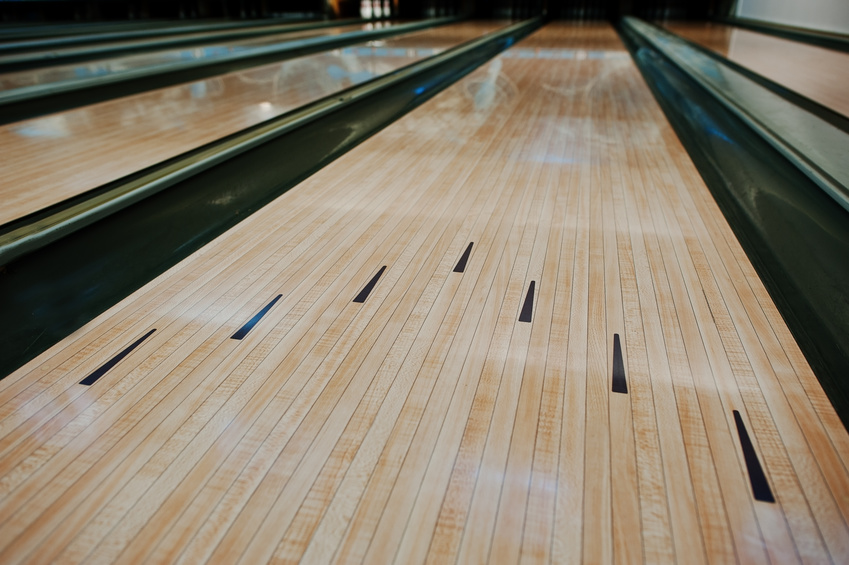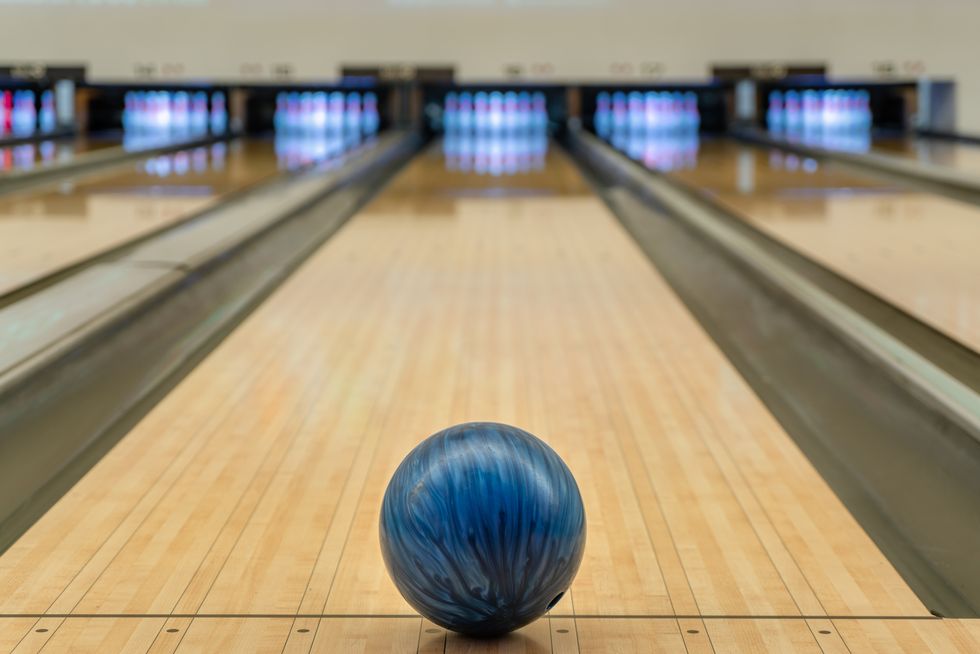Bowling alleys hold a special place in the hearts of families, friends, dates, and professionals alike. While most bowling alleys can accommodate 12 to 36 lanes, the exact dimensions of these lanes often remain a mystery.

Contents
Bowling Lane Dimensions
Let’s delve into the details of a bowling lane:
- Length: 60 feet
- Width: 42 inches
- Gutters: 9 ¼ inches wide on each side of the lane
- Pin deck from headpin: 2 feet and 10 ¾ inches.
For clarity, the pin deck is where the pins are set at the back of the lane. The headpin, positioned at the top end of the triangular formation, extends 2 feet and 10 ¾ inches from the rear of the pin deck.
When measuring the entire length of the lane, from the pinsetter machine to the foul line, it spans 65 feet and 10 3/16 inches.
The standard measurement for a bowling alley’s length is from the foul line to the headpin. The foul line marks the boundary between the player and the lane – crossing it results in a foul. The term headpin indicates the position of the first pin in the triangle formation.
Professional bowlers use approach dots to gauge their steps before reaching the foul line. These markers come in two sets: one positioned 12 feet away from the line and the other slightly further at 15 feet. This method allows players to measure the distance of their approach with precision.
Without these reference points, players may misjudge the length of their strides, leading to unintentional fouls by stepping over the line. Conversely, players might stop short by half a step, starting their bowl prematurely before reaching the foul line, and failing to utilize the available space effectively.
These dots provide a clear guide for players to approach the foul line and prompt others to make way. While casual bowlers may not utilize these approach dots, they are crucial for professional players.
Approach dots usually resemble arrow indicators at the 15-foot mark before transitioning into dots at the 12-foot mark.
Understanding Bowling Lane Dimensions
The bowling lane spans 60 feet in length (excluding the space from the pinsetter machine to the foul line) and is segmented into three equal parts, each consisting of sections measuring 20 feet.
The division of bowling lanes into equal parts remains largely a mystery. Yet, it is speculated that professionals utilize these segments to gauge their ball’s response to distinct angles and oil patterns. This practice can aid in mastering the art of curving a ball effectively, considering the specific oil distribution on the lane.
What Are Bowling Lanes Made Of?
Bowling alley lanes, stretching 60 feet, consist of narrow wooden boards, each about an inch wide. Approximately 39 of these boards span the width of a complete bowling lane. Treated and painted for durability, they endure the weight of bowling balls and frequent oiling.
Bowling lanes are equipped with broad gutters on both sides to prevent rogue bowling balls from rolling off the lane.
These gutters, usually constructed from steel, are designed to endure the weight and force of a bowling ball. They are lightly oiled to facilitate the smooth sliding of the ball towards the pin deck area, where it is then directed back to the pinsetter machine.
Next to the gutters are retractable bumpers that automatically adjust. Typically crafted from robust materials such as steel with a sturdy plastic coating.
The bumpers automatically raise and lower based on the player’s choice, aiming to keep the ball from rolling into the gutter.
The bumpers span the full length of the lane and gutters. Even when in place, they do not alter the lanes.
Guidelines for the Approach Area
Each bowling lane is required to have an approach area that meets specific regulations. This section should match the width of the lane and extend up to 15 feet from the foul line. Additionally, the approach should be marked with dots at the 15-foot and 12-foot distances from the foul line.
Players must adhere to this designated area to prevent injuries to themselves or others. A proper bowling technique involves taking a stride towards the lane before releasing the ball, hence necessitating ample space for movement and swinging of the ball.
This space doesn’t obstruct the social area behind the pinsetter machine, minimizing the chance of anyone getting hit while playing.
Bowling alleys vary in their layout, particularly in the positioning of the pinsetter and ball return machine. Whether they are near the foul line or the approach area doesn’t affect gameplay as long as they don’t obstruct players.
Bowling Lane Arrows
If you’ve ever wondered about the arrows on the lanes at a bowling alley, let’s explore their purpose. These arrows, known as approach dots or marks, are placed 15 feet and 12 feet before the foul line.
Arrows are marked on the lane itself, each about the width of a 1-inch board and no longer than 1.25 inches. These arrows are located on the boards at the 5, 10, 15, 20, 25, 30, and 35 positions. They form a V shape, with the final arrow pointing directly at the headpin.
These elongated triangular black arrows stand out as a unique characteristic. Interestingly, not all bowling alleys have them on their lanes. Although these markers don’t play a significant role in gameplay, they are not considered essential for every lane in every bowling alley.
The reason for the arrows on the lanes continues to puzzle many. It is believed that professionals use these arrows as markers during practice, indicating areas on the lane where the ball deviates from its intended path.
Pin Deck Dimensions
As previously stated, the pin deck is the section at the end of the bowling lane where the pins are positioned. This area comprises 10 pins arranged in a V-shape, with the front pin, also called the headpin, being the closest to the player.
The pin deck spans just over 2 feet (2 feet and 10 3/16 inches precisely) from the back row of pins to the headpin. Each pin measures 4.75 inches in width and 15 inches in height, spaced 7.25 inches apart. They are meticulously arranged to ensure fairness in the game.
Exploring Bowling Lanes and Regulations
Each bowling lane must adhere to the standards set by the United States Bowling Congress (USBC). Without meeting these requirements and specific lane dimensions, the bowling alley is unable to accommodate leagues or championships.
While suitable for bowling alleys catering to kids and families, this approach hinders the bowling alley from attracting a dedicated crowd of bowling enthusiasts.
Home Bowling Lane Dimensions
If you’re fortunate to have space for a home bowling lane, you might be curious about the dimensions required to bring your bowling dream to life.
For optimal bowling setup, consider allocating space for a 60-foot lane, a 16-foot approach, around 7 feet for the pins, and a 3-foot service aisle. In total, this would amount to 86 feet.
If space is limited, you don’t have to meet all the requirements. A 55-foot-long bowling lane can still offer valuable practice and contribute to the arcade-style look you’re aiming for.
Primarily, ensure that your home bowling lane is constructed on a surface capable of bearing heavy loads. Avoid placing it on the first or second floor as bowling balls and machines are substantial.
Typically, individuals construct their bowling lanes in the basement or an outdoor extension.
Conclusion
Here’s a comprehensive guide on bowling lane dimensions:
- The lane spans 60 feet from the headpin to the foul line.
- The lane width is 42 inches.
- The gutters, each 9 ¼ inches wide, run alongside the lane.
- Pins reach 2 feet and 10 3/16 inches from the back of the pin deck to the headpin.
- Approach dots are placed 15 and 12 feet before the foul line.
Bowling alleys must adhere to these USBC regulations for league and competition use. If you plan to construct a home bowling lane, ensure it meets these criteria or opt for a slightly shorter 55-foot lane on a stable surface.
Bowling lane dimensions are an important aspect of the sport, whether you’re a casual player or a professional. The United States Bowling Congress (USBC) has set strict regulations for the standard lane dimensions used in league and competition play. These regulations not only ensure fair play but also provide consistency for players across different alleys.
The dimensions of a bowling lane may seem simple, but there’s more to it than just its length and width. In this guide, we’ll break down the specific measurements of a bowling lane and highlight their significance in the sport.

Allow me to introduce myself – I’m Eric Wilkinson, a true bowling aficionado. The world of bowling culture has always fascinated me, and I’ve made the exciting decision to share my passion through writing. As I embark on this blogging adventure, my goal is to provide fellow enthusiasts with valuable insights, tips, and captivating stories. Through my blog, I hope to ignite a deeper appreciation for the sport and foster a sense of community among fellow bowlers. Join me on this thrilling journey as we explore the vibrant world of bowling together.
